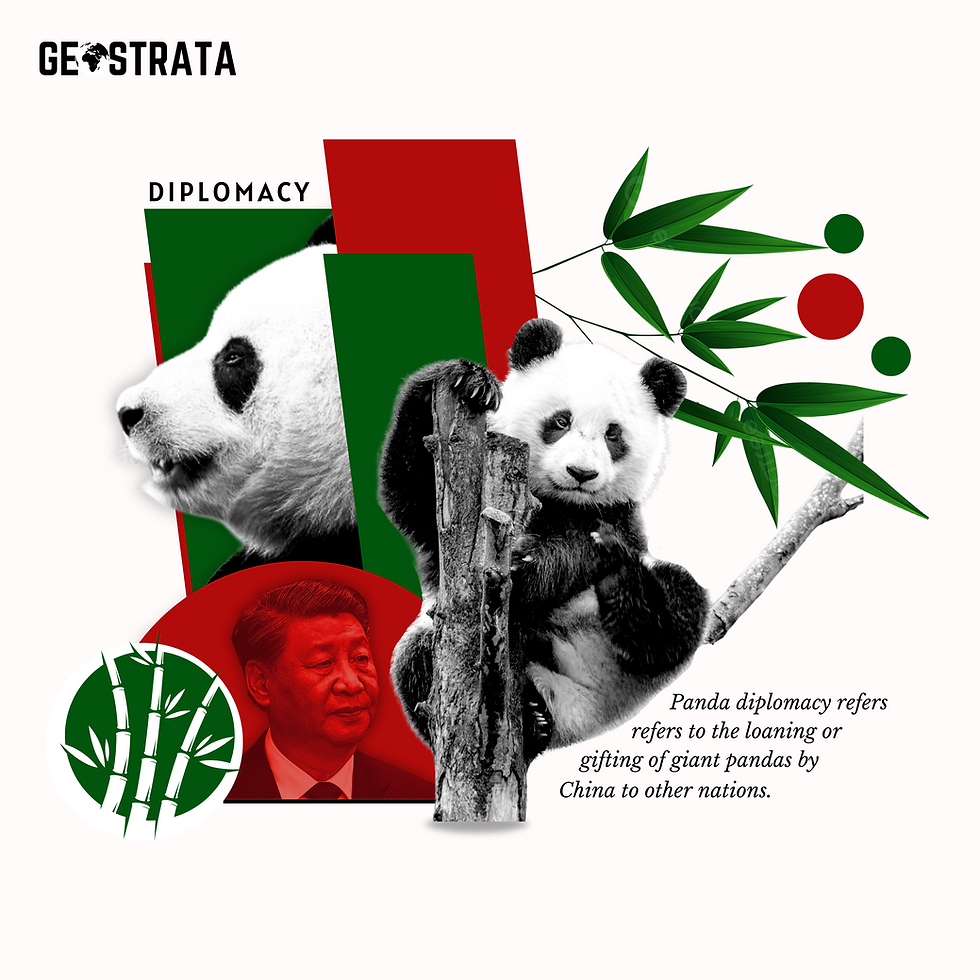Furry Envoys - The Pawprint Diplomacy
- THE GEOSTRATA
- Feb 1
- 3 min read
Updated: Mar 11
A dinner between Chinese Premier Zhou Enlai and the Nixon entourage revolutionised the international system. Mrs Nixon conversed with Premier Lei regarding the tour of Peking and the Zoo where she saw the Pandas.
Illustration by The Geostrata
Once, as she glanced at the table earlier than her, a peculiar container caught her eye – wrapped in delicate crimson tissue and decorated with captivating Chinese panda patterns. With an enchanted smile, she held it up, remarking to him, "Aren't they lovely? I love them."
His response became rapid and decisive, "I'll provide you with a few," and as a result, the wheels had been set in motion to have two graceful pandas shipped throughout the globe, destined for the National Zoo in Washington.
The result was that the US recognised the People’s Republic as the sole representative of China. This shows how Pandas can be used by China as a geopolitical tool to accomplish its objectives. Consequently, this article will address the historical origins and how under the CCP the practice of Panda Diplomacy works, Then provide Case Studies and its implications to One China Policy and the political implications. We then conclude the essay by summarising the above points.
HISTORICAL BACKGROUND
Panda diplomacy refers to the loaning or gifting of giant pandas by the People’s Republic of China to other nations. It enhances China's smooth power by gifting pandas to foster goodwill. This practice began in ancient times during the Tang Dynasty wherein two bear-like beasts were given to Japan during the reign of Wu Zeitan (624-705). As of the early 20th Century it was established as a peculiar form of diplomacy, especially during World War II.
The then First Lady, Soong Mei-Ling, of the Republic of China, in November 1941 gifted two pandas to the United States as a present for helping China fight against the Imperial Japanese occupation of China. In China, Pandas preserve giant cultural fee in China as symbols of peace and national pride. They are taken into consideration as a "national treasure" and have been used as diplomatic equipment to foster goodwill and toughen worldwide ties.
Known as "熊猫" (Xiong Mao) because of historical analysing practices, they're endangered, with around 1,596 wild pandas recorded in 2006.
Chengdu's Research Base of Giant Panda Breeding is the foremost centre for panda conservation, attracting international tourists. Pandas' rarity and appeal underscore their position in promoting conservation and international collaboration. The next section will talk about times when China has utilised Panda Diplomacy to further advance its cause and help in its Strategy to advance its interests.
NOTABLE EXAMPLES OF PANDA DIPLOMACY
Post-1949, with the victory of the Chinese Communists over the Nationalists, the former was able to take control of Pandas in Mainland China. During Mao Zedong’s era, we were able to see the People’s Republic of China provide 24 pandas to 9 nations. The few nations China sent included the Soviet Union, the Democratic People’s Republic of Korea, the United Kingdom, the United States, and Mexico.
These countries had recognised the People’e Republic as the legitimate representative of China. A longstanding diplomatic tool, panda diplomacy has been used by China to enhance its soft power.
One of the most well-known examples turned in 1972 when China’s two large pandas, Ling-Ling and Hsing-Hsing, to America following President Nixon's historic go to, signifying the re-established order of diplomatic ties.
More these days, in 2011, China loaned a pair of pandas named Tian Tian and Yang Guang to the Edinburgh Zoo in Scotland for a 10-yr duration worth £6.6 million, celebrating the UK-China partnership, in particular inside the electricity sector after the 2 international locations signed an oil deal.
Image Credits: Rightful Owner
However, China's panda lending practices have confronted scrutiny in recent years, performing increasingly more transactional and political, as exemplified by the recent decision to gift new pandas to the U.S.
At the same time as recalling them from other Western international locations vital to China's regulations on problems like Taiwan and human rights, underscoring how massive pandas continue to be a symbolic diplomatic tool to reward or deny admission based on accommodation of Beijing's pastimes.
Panda Diplomacy, a longstanding exercise of gifting or loaning giant pandas via China, has developed into a strategic tender power tool under the Chinese Communist Party. With roots relationship lower back to ancient instances, pandas have ended up symbolic gestures of friendship and cooperation, profitable countries that align with China's interests whilst denying entry to those critical of its rules.
Recent examples, like recalling pandas from Western nations over Taiwan and human rights problems, underscore how those endangered animals remain a diplomatic leverage for China to enhance its political and monetary interests globally.
Furry.
BY SANJAY GURURAJAN
TEAM GEOSTRATA
.png)


Comments